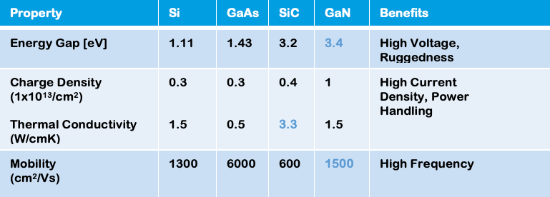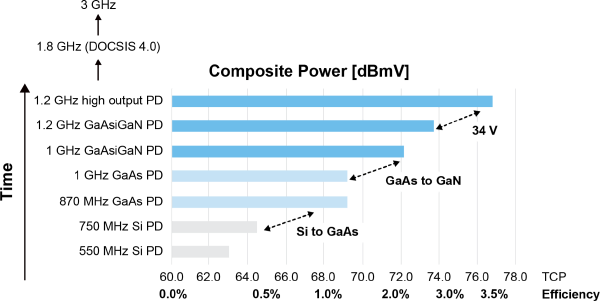How GaN Helps CATV Providers Find Balance
June 16, 2022
Demand for Speed, Capacity, Performance and Reliability
There’s a demand for greater cable speeds and higher capacity data transmission with everyone consuming video, music, games and online publications. And it’s left North American cable operators in a quandary about how to enhance their networks to meet the requirements without degrading signal integrity and performance. Enter gallium nitride (GaN) power amplifier technology, which exhibits the required linearity, thermal characteristics and efficiency to satisfy hybrid fiber-coaxial (HFC) performance requirements and deliver reliable community antenna television (CATV) operation.
This post is an excerpt from the Design Summit series of Qorvo webinars that highlight vital improvements in industry sectors where evolutionary advances are powering next-generation technologies.

Take a Deeper Dive
Explore this topic in greater detail as part of the Design Summit series with Qorvo experts. These webinar sessions cover advances that are enabling revolutionary next-generation technologies.
Evolution of Gain Block Amplification
Over the past 25 years, CATV technology consisting of gallium arsenide (GaAs), GaN hybrids and monolithic microwave integrated circuits (MMICs) has advanced to extend bandwidth and increase system performance. In order to keep pace with the latest data over cable service interface specifications (DOCSIS). GaN devices deliver more than the necessary efficiency, linearity and performance to ensure reliable data transmission and signal integrity across HFC networks.
Technological Evolution of Semiconductors used for CATV
With the improvements in gain-block performance when using GaN technology, CATV multiple system operators (MSOs) can increase linear power output. The benefits include lower costs when upgrading and the possibility of locating fiber closer to the customer for better service. In addition, there is the added benefit of reducing or eliminating amplifiers in the network chain.
Figure 1 compares the relative characteristics of the material technologies commonly used in CATV gain-block architecture. You can clearly see that GaN provides several key system-level benefits for the MSO.

Figure 1. Characteristics of GaN-based components compared to other semiconductor technologies.
Improving Linear Power Output with GaN
Contending with nonlinear behavior in active power devices presents a significant challenge as the industry moves beyond DOCSIS 3.0 and DOCSIS 3.1 to DOCSIS 4.0, a standard that supports up to 1.8 GHz of downstream spectrum. Inconsistent linearity degrades signal quality, generating bit errors on digital channels and sometimes results in complete device failure when demodulating the signal. Using GaN helps mitigate the possibility of degraded linearity—helping to avoid signal quality issues and device failures.
Qorvo’s expertise in designing and manufacturing CATV amplifiers stretches back to the earliest stages of this industry. In fact, Qorvo was the first company to introduce CATV gain blocks using gallium nitride on silicon carbide (GaN-on-SiC).
Using GaN, with its superior performance characteristics, has led to a large-scale shift from GaAs to GaN in CATV applications. The combination of higher output levels, greater durability and superior thermal performance offered by GaN have been the key catalysts behind much of this shift.
As CATV bandwidths continue to be extended, engineers and system architects are looking for the best technologies for their network upgrades. In order to meet demands for the increased bandwidth and data rates, linearity must be maintained. Sustaining the linearity of a gain block or amplifier depends primarily on four factors: semiconductor technology, circuit design, power consumption and thermal design/properties. GaN offers advantages in these areas, providing up to 10 W/mm, compared to 1 W/mm for typical GaAs designs (see Figure 2).
Advances in Linear Output Power

Figure 2. A comparison of efficiency and composite output power for GaAs, GaN and Si technologies.
Some Final Thoughts
MSOs now have solid options for addressing the capacity demands when upgrading their networks to the new DOCSIS standards. GaN technology delivers better data transmission and has the necessary characteristics to adapt to rigorous design constraints, and GaN-based amplifiers provide the ideal building blocks for these next-generation designs.
Access the video of this webinar to learn more about the capabilities of GaN technology.
Other related resources can be found on the Qorvo Design Hub. The hub offers a broad selection of block diagrams, design tools, brochures, e-books, white papers and other content to help you build solutions efficiently using Qorvo components.
Have another topic that you would like Qorvo experts to cover? Email your suggestions to the Qorvo Blog team and it could be featured in an upcoming post. Please include your contact information in the body of the email.
